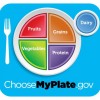 After introducing MyPlate in June 2011, USDA provided a series of one-page fact sheets to help consumers use the dietary advice of the Dietary Guidelines 2010. The USDA added new fact sheets in December 2011 and continued adding fact sheets in 2012, 2013, and 2014. These fact sheets are distributed by UF/IFAS Extension for Extension faculty, health professionals, and consumers. They are also called the “Ten Tips Nutrition Education Series” and “DG TipSheets”
After introducing MyPlate in June 2011, USDA provided a series of one-page fact sheets to help consumers use the dietary advice of the Dietary Guidelines 2010. The USDA added new fact sheets in December 2011 and continued adding fact sheets in 2012, 2013, and 2014. These fact sheets are distributed by UF/IFAS Extension for Extension faculty, health professionals, and consumers. They are also called the “Ten Tips Nutrition Education Series” and “DG TipSheets”
New in 2014:
- 32. Make Healthier Holiday Choices
- 33. Men’s Health: Get the Facts to Feel and Look Better
- 34. Teen Guys: Choose the Foods You Need To Grow
- 35. Women’s Health: Make Better Food Choices
- 36. Teen Girls: Eat Smart and Be Active As You Grow
- 37. Save More at the Grocery Store
http://edis.ifas.ufl.edu/topic_myplate_nutrition_education_series




 Along with their introduction of MyPlate in June 2011, USDA provided a series of 14 one-page fact sheets to help consumers implement the dietary advice of the Dietary Guidelines 2010 in their daily lives. The USDA added four new fact sheets in December 2011. These fact sheets are being distributed by University of Florida IFAS Extension for use by Extension faculty, health professionals, and consumers in Florida.
Along with their introduction of MyPlate in June 2011, USDA provided a series of 14 one-page fact sheets to help consumers implement the dietary advice of the Dietary Guidelines 2010 in their daily lives. The USDA added four new fact sheets in December 2011. These fact sheets are being distributed by University of Florida IFAS Extension for use by Extension faculty, health professionals, and consumers in Florida.